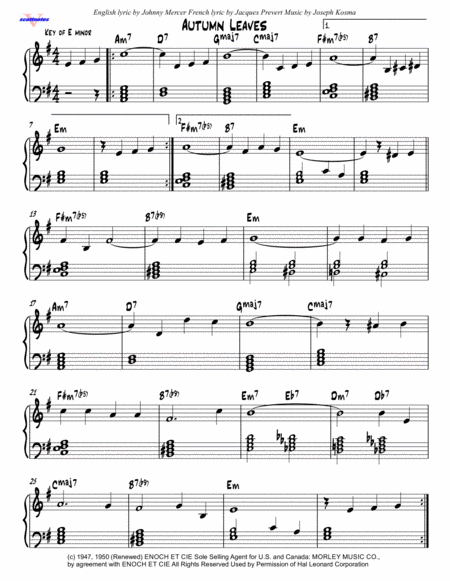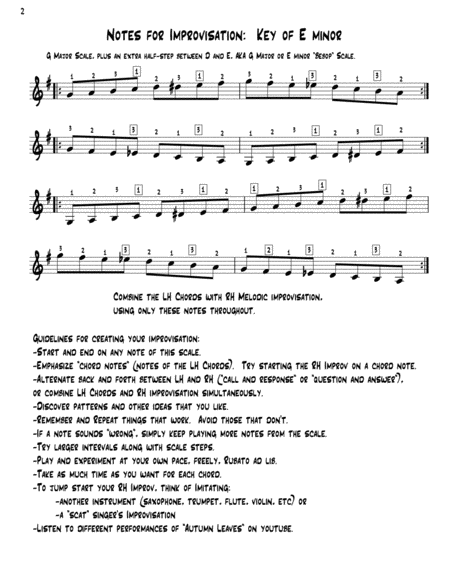Autumn Leaves (Learn the Secrets of Jazz Piano Improv)
Details
Description
SKU: H0.587121-47880
By Joseph Kosma. Arranged by Scott Camp. 4 pages. Published by Scott Camp (H0.587121-47880).Perfect Adult Piano Activity. Great introduction to jazz piano improvisation.
Use this to learn/teach jazz piano improvisation.
Page 1 (shown) presents the familiar melody with simple chord accompaniment.
Page 2 presents the notes with piano fingering to use for improvising over the complete song.
To me, "Autumn Leaves" is the best way to learn how the "Bebop" scale is used, and why the "Bebop" scale is truly the greatest scale for improvising jazz standards.
The "Bebop" Scale explained
As long as music stays in the same key (including its relative major or minor), the best sound is when the "Bebop" scale is used throughout for each and every chord.
In this case, "Autumn Leaves" is in the key of E minor, with parts in its relative major G, remembering that a key and its "relative" share the same key signature.)
So... The "Bebop" scale which fits the entire set of chords is either:
G Major Bebop Scale G A B C D D# E F# G
E minor Bebop Scale E F# G A B C D D# E
The only formulae for constructing Bebop Scales are:
For Major Keys, add a half-step between 5 and 6.
For minor keys, add a half-step between 7 and 8.
As you can see, this results in the same exact scale.
And, even better, you use this same scale for every chord symbol of the song.
There is no "changing scales" with each changing chord symbol.
Sure, you will want to acknowledge chord tones as the chords change, but the SCALE remains the same throughout.
What scale is best for Amin7? For D7? GMaj7? CMaj7? F#min7b5? B7b9?
Answer: G Major Bebop Scale (same as E minor Bebop Scale)
In summary, the "Bebop Scale" is NOT a scale which changes with each new chord symbol.
The "Bebop Scale" applies to all chords in a prevailing key. If the music doesn't modulate (change key), then the Bebop scale doesn't change either.
If you dig in to the use of the Bebop Scale, you will be rewarded with that great sound you've always heard and liked.
PS When I searched youtube, I remembered that G minor is perhaps the most common key for "Autumn Leaves".
That's why I've included both keys here.
Improvisation activities are challenging because if everything is notated, then it sounds great but it's just another reading activity.
The goal here is to become less dependent on a "piece of paper" and really look at the keyboard while you're playing.
I know it's a scary thought, but for maximum effectiveness, the student must memorize the LH chord progression by itself as well as the RH scale. The good news is that the chord progression to "Autumn Leaves" is strong, clear, and iconic as it follows the cycle of 5ths. Every musician should know this chord progression "by heart" in at least one key.
Parting thoughts: Understanding the interaction of harmony and melody in "Autumn Leaves" is a microcosm of how all music works at a remarkably in-depth level, as it includes the concepts of key, major and minor scales, relative major and minor, cycle of 5ths, ii V7 I progressions in both major and minor keys, all the chords in a given key, 7th chords, and cadence.
Digital Downloads are downloadable sheet music files that can be viewed directly on your computer, tablet or mobile device. Once you download your digital sheet music, you can view and print it at home, school, or anywhere you want to make music, and you don’t have to be connected to the internet. Just purchase, download and play!
PLEASE NOTE: Your Digital Download will have a watermark at the bottom of each page that will include your name, purchase date and number of copies purchased. You are only authorized to print the number of copies that you have purchased. You may not digitally distribute or print more copies than purchased for use (i.e., you may not print or digitally distribute individual copies to friends or students).


 Share
Share